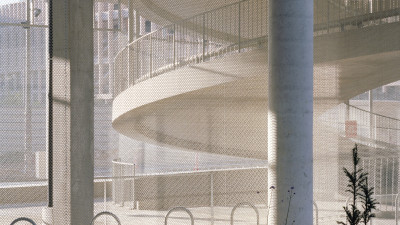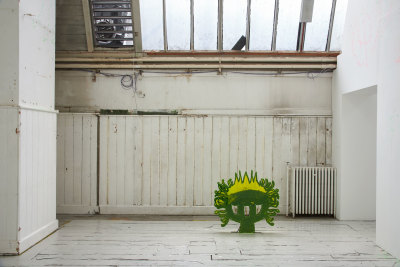Britain’s top 10 maverick buildings
Britain’s top 10 maverick buildings
By Helena Cuss
Published 1 April 2016
To celebrate the end of our Mavericks season, we asked you to nominate your favourite boundary-pushing buildings in the UK. Here’s what you came up with.
-
Throughout the spring Architecture season at the RA, we’ve been interrogating the term “maverick” in architecture. When applied to buildings, it could mean an unorthodox or bold design that refuses to bow to fashion or convention. But we’ve also explored what it means to be a maverick architect – we compiled some of Britain’s best, from Robert Smythson to Zaha Hadid RA – someone who questions what the discipline of architecture is, and how it should be practiced.
When it came to thinking about Britain’s best maverick buildings, we asked you to send in your nominations via email and vote on our Twitter polls. From your dynamic and diverse list, we’ve whittled it down to a top ten.
Preston Bus Station, Lancashire
Preston Bus Station beat Nicholas Grimshaw’s Eden Project in our first Twitter poll, in which we pitted the architecture of the everyday against the fantastical. Built in 1969 by Building Design Partnership, this starkly modern amenity in Lancashire has been the object of both censure and praise since its construction. Its colossal scale – a double height ground floor and 40 gates for buses – brought it close to demolition in 2013 as necessary renovations grew to an estimated at £23m. However, an outcry from local residents and architects, who cited the curved concrete balconies as quintessential Brutalist design, led to its listing by English Heritage.
-

Preston Bus Station by Building Design Partnership, 1969
Photo © User:Dr Greg / Wikimedia Commons / CC-BY-SA-3.0
-
Wells Cathedral, Somerset
Under the soaring vaulted ceiling of this Gothic cathedral, two arches are entwined in what appear to be a modern addition to the 12th-century fabric. The “scissor arches” were in fact added in 1338–48, an idiosyncratic solution by master mason William Joy to cracking foundations under the bell tower, which went on to enhance this building’s reputation as one of England’s most beautiful religious buildings. It triumphed over 21st-century cathedral of commerce, the Shard, in our Twitter poll.Trellick Tower, Ladbroke Grove, London
Another icon of 1970s Brutalism, this housing block in West London was built by Hungarian architect Ern? Goldfinger. In the same distinctive design as his earlier Balfron Tower in East London, the main structure is joined to a sibling tower, which houses its lift and services. Tower blocks were already going out of fashion by the time of its completion in 1972, with associations of crime and anti-social behaviour, so it is a testament to its grip on the nation’s popular imagination that it was listed in 1998. It has been cited at the inspiration for two canonical works in dystopian literature: J.G Ballard’s High Rise, and Martin Amis’s London Fields.Oriel Chambers, Liverpool
Liverpool’s Oriel Chambers is a Victorian office building with a difference. Built by Peter Ellis in 1864, critics at the time were horrified by its “large agglomerations of protruding plate glass bubbles”. In fact, it was a precursor to Modernist architecture, being the first building in the world to feature a metal-framed glass curtain wall, a design element which creates light, airy interiors and has since been used the world over as a defining feature of skyscrapers. On Ellis’s façade the curtain wall is made up of “oriel” windows, a type of bay window, from which it gets its name.
-

Wells Cathedral, view down the nave to scissor arches, 1176–1490

Trellick Tower, London, by Erno Goldinger, 1972

Oriel Chambers Liverpool, by Peter Ellis, 1864

Lloyd’s Building, London, by Richard Rogers, 1986
-
The Lloyds Building, City of London
Designed by Richard Rogers RA and famously known as the Inside-Out Building, this was nominated by Piers Gough RA. Like the Pompidou Centre in Paris, also designed by Rogers, the Lloyds building has become an icon of modernity by making visible all those things usually hidden from sight: staircases, lifts, ductwork and water pipes. It is the youngest building to have ever been listed by Historic England (previously English Heritage), winning Grade I listing just 25 years after completion.Stonehenge, Wiltshire
In our Twitter poll, this famous structure was picked over Sir Denys Lasdun’s National Theatre. Two monolithic giants from vastly different eras, these equally imposing structures are symbolic of different aspects of British national identity. Unquestionably Britain’s most mysterious building, the origin and meaning of Stonehenge has confounded historians for centuries. Believed to have been constructed between 3000 – 2000 BC, the ring of monumental standing stones may have been a burial ground, and continue to speak eloquently of Britain’s pagan and mythological past.
-

Stonehenge, Wiltshire, c. 3000-2000 BC
Photo © Guenter Wieschendhal, in the public domain
-
Brighton Pavilion, Brighton
Brighton Pavilion is surely one of the most incongruous buildings to inhabit the British seaside, with its bulbous Indian-style domes and minarets. It was designed by architect John Nash for George, Prince of Wales, (later George IV), as a Royal residence away from the bustle of London. Here, the famously flamboyant and gregarious Prince could entertain his mistress, Maria Fitzherbert, and recover from gout. It is a perfect example of the Regency taste for all things exotic and oriental, which was gripping Europe throughout the period.
-

Brighton Pavilion by John Nash, 1823
Photo © User: flamenc / Wikimedia Commons / CC-BY-SA-3.0
-
Bournemouth Drawing Studio, Bournemouth
Despite being in the profession for over 50 years and at the forefront of one of Britain’s most influential and avant-garde architecture collectives, Sir Peter Cook has only just completed his first built project in the UK: an irregularly shaped blue pod on the campus of Arts University Bournemouth. Every element of the design – from the two enormous oculi to the white interior walls – celebrates and promotes natural light, invaluable in the practice of drawing.
-

Bournemouth Drawing Studio, Arts University Bournemouth, by Sir Peter Cook of CRAB Studio, 2016
Photo © Richard Bryant
-
St Paul’s Cathedral, London
This famous London landmark narrowly beat Tate Modern in our final Twitter poll, in which we opposed London old and new, occupying either end of the infamous “Wobbly Bridge” across the River Thames. From 1710 to 1962 the recognisable sight of Sir Christopher Wren’s monumental dome dominated the London skyline. Wren’s unique fusion of Palladian, neoclassical ornamentation with 17th century Roman baroque design and the tradition of English medieval cathedrals means that the building continues to have an iconic presence in the imaginations of Londoners and tourists alike, despite being increasingly overshadowed by skyscrapers in the nearby financial district.
-

St Paul’s Cathedral, London, by Sir Christopher Wren, 1710
Photo © Helena Cuss
-
Tate Modern, London
Despite originally being pipped to the post, Tate Modern was still nominated for its ground-breaking conversion of an industrial power station into a mecca of modern and contemporary art. Originally designed by Sir Giles Gilbert Scott in 1947, Bankside Power Station was closed in 1981. After an international competition in 1995, architects Herzog & de Meuron were commissioned to design a new gallery for the Tate, and instead of knocking down the structure, they began adapting it. The cavernous Turbine Hall, in particular, has retained many of its original industrial characteristics, and with a height of five storeys has become a unique display space for contemporary art commissions since the museum opened in 2000.
-

The Turbine Hall at Tate Modern, London, by Herzog & de Meuron (original building Sir Giles Gilbert Scott, 1952) 2000
Photo © Helena Cuss
-
The debate isn’t over yet. On 18 April, we’ll be hosting a panel discussion with the leading figures in architecture and heritage, and we’ll ask our speakers to choose their top maverick buildings. Get involved and tell us what you think by tweeting @architecture_RA or using the hashtag #MaverickArchitects.
Mavericks: Breaking the Mould of British Architecture is at the RA until 20 April.













